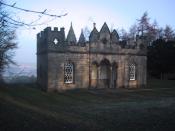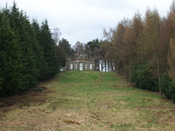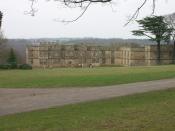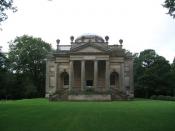The Gibside Estate.
''It has even now, after nine years neglect, sufficient majesty to engage the attention of every traveller fond of romantic scenery.'' Britain was one of the strongest nations in the world in the Georgian period, and this is reflected in the architecture of the time. In fact, the eighteenth century, in Northumberland, is often referred to as the 'Great Awakening' , in reference to the formidable constructions of country houses. It was a competitive arena for architects to demonstrate their skills, and for patrons to indulge in their fantasies of nobility and antiquity, as well as expanding their estates. George Bowes, (1701-1760), was a member of the landed elite in Northumbria, and his property, Gibside, forms the focus of my study. By analyzing the designs and possible influences of the many buildings on the Gibside estate, I hope to provide an insight into the incredible legacy of George Bowes, as well as analyzing the cultural and historical significance of the architecture itself.
Gibside estate is vast, so I will focus, mainly, on the buildings that I was able to make a visual assessment of, and give some brief detail into the further development of the estate after George Bowes' death. I will acknowledge the architect and references to any architectural movements in my observations, and an occasional look at the landscape of the Gibside estate is necessary, as this plays such an important role for Bowes and eighteenth century ideals.
George Bowes, (1701-1760) was the youngest of ten children, so it was due to the tragic deaths of his elder brothers that meant he inherited the Gibside estate. In a period where there was the ''assertion of social, political and most importantly, cultural domination by the elite,'' George can be seen as a typical aristocrat of his time. He appears to follow tradition, as history tells it, joining the army aged eighteen, as befitted a younger brother not to inherit the land of his father, inheriting Gibside, in fact, the same year as he obtained his majority. Bowes had been a good student at school, and loved music, art and architecture, striving to acquire knowledge while at Gibside. He subscribed to the Society for the Encouragement of Learning in London, and was good friends with Thomas Robinson (1700-1777), a follower of the 3rd Earl of Burlington, (the arbiter of Palladian taste.) A few major, influential books for the century, on architecture, are recorded as being subscribed to by Bowes, such as Palladio's 'The Four Books of Architecture' and Will Kent's 'The Designs of Inigo Jones'.
As well as educating himself on the arts, Bowes keenly entered into traditional gentleman's sports and social activities such as horseracing, (buying and betting), hunting and cards. Bowes He also was married in 1724 to his beloved, extremely young wife Eleanor Verney. Her tragic death after only two and a half months left him devastated for several years. Business and politics seem to have been the solution for George Bowes, he followed the tradition of landed gentry into the world of politics, becoming a member of Parliament for the County of Durham in 1727. Despite being occupied with exploiting coal deposits on his estate, Bowes was now prepared to improve his estate and grounds visually. He began by ruthlessly moving the whole of Gibside village from the east of Gibside House in an effort to improve the view of his land. He was doubtlessly an arrogant and strong willed businessman, he is said by Margaret Wells in her book, 'Gibside and the Bowes family', to have paid voters ã20 each to elect him at the Morpeth election in 1723. Having gained a more aesthetically pleasing landscape to start building on his estate, Bowes began to pay architects for designs of a new Gibside.
In 1731, Stephen Switzer, (1682-1745), an important figure in the history of landscape design, sent Bowes at least one plan for the grounds at Gibside. Another architect, William Etty, (c.1675-1734), is also recorded to have given plans, but there is little evidence of them being used. This is in lie with George Bowes favoured practice, of getting the best possible advice and relying on it when it suited his own ideas. Switzer's plans for the gardens, plantations, walks and general layout, were followed by Bowes in the years to come, and yet the work was carried out by estate labour without Switzer's supervision. The general layout was precise, consisting of straight walks and rides near the house, in the French style that remained popular until the mid 18th century. The Grand Walk can be attributed to Switzer's plan for a grand avenue, but was not carried out until 1746, and I will detail my impression of the great walk, and the history of it's development later in the essay.
A present-day Northumbrian archeologist, Henry Beamish, described Gibside to me as a series of set piece paintings. This is relevant to the period of the 18th century, as grandiose landscape paintings, of Italian origin especially, were popular, and may have been influential in Bowes' development of 'framed' landmarks around his estate. For example, the octagon basin, developed in the early 1740s, had a wide alley leading up from it to the site of the Gothic Banqueting house, to a layout planned by Switzer. Standing at the large octagon pond, (not easy now to distinguish it's original shape), one's eye is drawn up to the folley directly in front, high on the hill, and framed by the surrounding trees. The octagon basin itself was the focus of a planned walk by Switzer, a landmark water feature. It is big enough to resemble a romantic lake, the trees planted around it also appear to enlarge the spectacle, and give a more natural, park-like impression. The transfer of affections from the ordered, precise French landscape style to a more natural, rural, park-like landscape began nationally about the middle of the 18th century, characterised by the work of Capability Brown. Although George Bowes layed out his immediate estate, (around Gibside House), in the grandiose, formal manner, which emphasised his elitist position, subsidiary paths on his estate were sinuous and he encouraged the planting of trees in clumps as a framing device for his buildings. This method, exploited by William Kent in the 18th century, promoting an enforced 'natural' look. However, the octagon pond would have had a far less 'wild' apearance in it's original state. It was designed with ampitheatre-like ramps in three stages above it, where classical statues were later displayed. The 18th century saw so many architectural references to ancient Rome partly due to greater knowledge of history and the arts, and a wish to emulate the grandness and dignity of the designs. There is no evidence that Bowes went on a Grand Tour to Rome or elsewhere, but he was not an innovator, more a learned follower, who found inspirational ideas through the work of others. The ampitheatre effect at the octagon pond, for example, resembled the one built at Claremont, Surrey, but on a much smaller scale. The aesthetic appeal of the octagon-shaped pond may have been inspired by a reference to 'an octagon Basin' in Batty Langley's book, 'New Principles of Gardening'(1728), which was popular at the time and even dedicated 'to the Nobility and Gentry of Great Britain'. There is also an octagon lake at Stowe, Berks, which Bowes had visited three years earlier in 1737. When the pond was built, so was a wide alley that led to a platform, which was to be the site of a future building, and made a bastion-like projection into the surrounding arable lands. This was part of Switzer's plan, for a fitting landmark, that would have it's approach enhanced by the link to the octagon pond, but would also be a place to view the estate and surrounding countryside.
The building of the Gothic Building, later to be known as The Banqueting House, began in 1741. The architect was Daniel Garrett,(d. 1753), a conscientious disciple of Lord Burlington, and a pioneer in the use of rococo plasterwork. He was recommended to Bowes by Sir Thomas Robinson, and had also worked at Wallington House in Northumberland, where Bowes may have become familiar with his work, including a central pediment to the front of Wallington Hall. It was one of the first Gothic buildings in the North of England, having been popular in the south in the 17th century, giving way to the favoured Palladian style of the 18th century. In fact, the structure of the building was planned to a symmetrical Palladian design, one great room, with two smaller 'wings', with which Garrett was familiar, and then decorated in a rococo-Gothic style, successfully masking its simple lines. Bowes may have been inspired by the belvedere tower at Whitton Park, Middlesex, where his mother-in-law Mrs Verney lived. The Gothic style gave the building a medieval appearance and fanciful, 'castle' style detail such as embattled side walls that are raised at the corners to simulate towers, add to the effect. These 'towers' are enlivened by quatre-foils cut into the brickwork. The building is fronted by a bay, surmounted by three pointed pinnacles. The windows are made up of hexagonal panes, with rounded panes in the cinquefoil heads. The hexagonal shape is characteristically Gothic, and used by William Kent, the protegee of Lord Burlington. They gave me the impression of an elaborate church window, the curvy 'ogee' arch at the top adding a fanciful, decorative appeal. The rear entrance is through a triple-bay portico in antis, the cinquefoil heads echoing the shape of the windows. The Gothic tracery is combined with decorative




